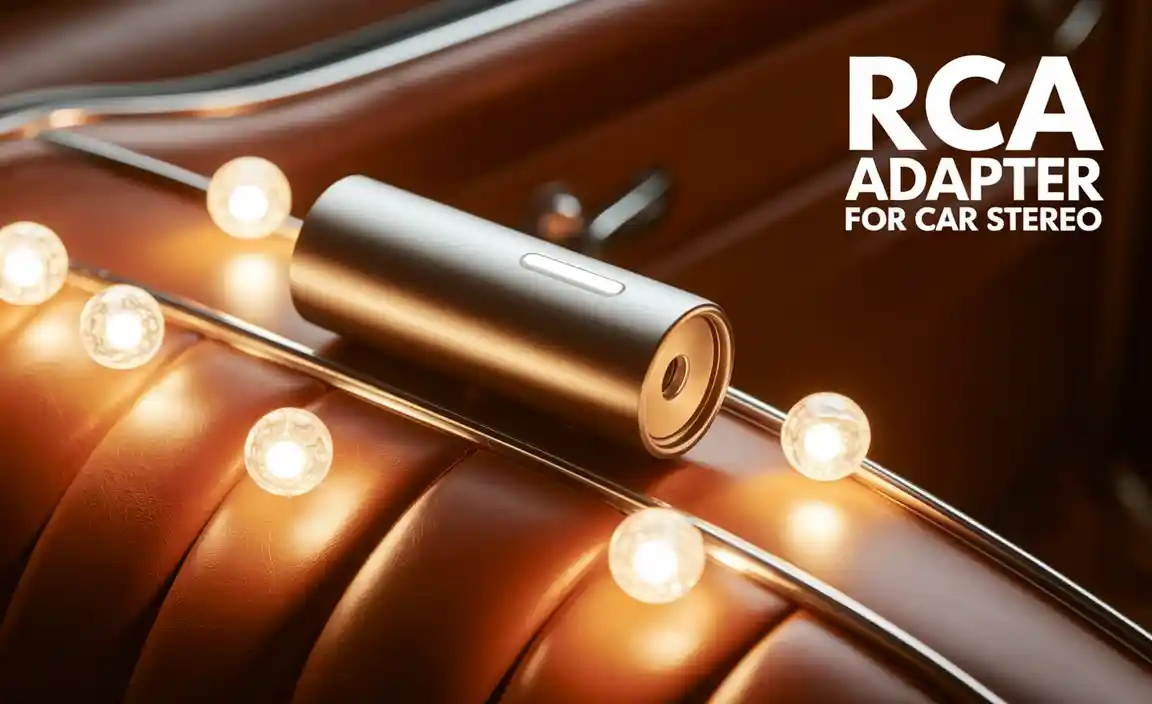Have you ever wondered why your car won’t start? It’s frustrating, right? One common reason could be a draw on your battery. A battery draw happens when something in your car uses power when it shouldn’t. This can drain your battery and leave you stuck.
Checking for a draw on a car battery can save you from many headaches. Imagine being late for work because your car won’t turn on. No one wants that! The good news is that finding out if you have a battery draw is simple. You don’t need fancy tools or special skills.
In fact, many people don’t realize they can do this check on their own. Once you learn how to check for a draw on a car battery, you’ll gain confidence. It’s like having a superpower for your car! Let’s explore this easy process together and keep your ride running smoothly.
How To Check For A Draw On A Car Battery Safely
How to Check for a Draw on a Car Battery
Is your car battery dying often? You might have a “draw” on it. A battery draw happens when something drains the battery, even when the car is off. To check for this, use a multimeter. First, turn off your car and all accessories. Then, disconnect the negative cable and attach the multimeter leads. A reading above 50 milliamps suggests a draw. Fun fact: Simple things, like leaving a light on, can cause battery drain. Knowing how to check helps keep your battery healthy and your car running!Understanding Battery Draw
Definition of battery draw. Common causes of battery draw in vehicles.Battery draw happens when your car uses power even when it’s turned off. This can drain your battery. Common causes include:
- Left on lights or accessories
- Faulty wiring
- Defective alarms or radios
- Malfunctioning alternator
Understanding these reasons helps prevent a dead battery. Keeping track of what uses power is important for car health.
What causes battery draw in vehicles?
Common causes include leaving lights on, bad wiring, and faulty devices. These issues can suddenly drain power, leaving you with a dead battery.
Signs of a Battery Draw
Symptoms indicating a possible battery draw. Diagnosing a dead battery situation.Some signs can show if your battery is having a draw. Here are a few to watch for:
- Dim headlights: If they seem weak, your battery may be draining.
- Clicking sound: A weak battery often clicks instead of starting.
- Dash lights stay on: If they don’t turn off, this can drain the battery.
- Frequent jump starts: Needing to jump start often is a clear sign.
Check for these signs. If you notice them, it might mean you have a battery draw. Diagnose the battery to find the issue. It’s better to find the problem early!
What are signs of a battery draw?
Watch for dim lights, strange sounds, and frequent jumps to spot a battery draw.
Tools Needed for Testing
Essential tools for checking battery draw. Safety equipment to use during the process.To check for a battery draw, you’ll need some important tools and safety gear. Start with a multimeter to measure power. Additionally, use insulated gloves to protect your hands. Safety glasses can shield your eyes. Don’t forget wire strippers for working with cables. Here’s a quick list:
- Multimeter
- Insulated gloves
- Safety glasses
- Wire strippers
Using these tools helps you stay safe and do the job right.
What tools are essential for checking a battery draw?
The essential tools include a multimeter, insulated gloves, safety glasses, and wire strippers. These items help you measure power accurately and keep you safe while testing.
Step-by-Step Guide to Check for a Battery Draw
Preparing the vehicle for testing. Disconnecting the battery safely. Setting up the multimeter for accurate readings.First, park your car and turn everything off. This includes lights, radio, and any other gadgets. You want the car to be as quiet as a mouse. Next, safely disconnect the battery. Always start with the negative terminal—it’s the cool kid on the block, avoiding sparks! Now, grab a multimeter. Set it to the right range to measure current. Make sure you know red is for positive and black is for negative. Like a superhero duo, they help you test for battery draws!
| Steps | Instructions |
|---|---|
| Prepare Vehicle | Ensure everything is turned off. |
| Disconnect Battery | Start with the negative terminal. |
| Set Up Multimeter | Adjust it to current measuring mode. |
Interpreting the Results
Understanding the current readings from the multimeter. What constitutes a normal vs. excessive draw.Reading the multimeter results is like deciphering a secret code! Typically, a normal draw is about 30 milliamps. Anything over that means your car may have a pesky power thief lurking! To help you understand, here’s a quick table:
| Current Reading (mA) | Status |
|---|---|
| 0-30 | Normal |
| 30-50 | Warning! Check for issues |
| 50+ | Excessive Draw! Investigate immediately! |
So, keep your eye on that meter! Your battery will thank you, and so will your wallet!
Identifying Problematic Circuits
How to isolate circuits to find the source of the draw. Tips for checking fuses and electrical components.To find the problem with your car’s battery, check its circuits. Start by removing fuses one by one. This helps see if a certain part is causing trouble. Look for any signs of wear on the wires too. If a fuse is blown, there may be a faulty electrical component. Check your lights and radio as they can drain the battery. This simple method can save you time and money.
How do I check for a faulty component?
Check circuits with a multimeter and look for a current draw, which can guide you to the faulty part.Tips for checking:
- Remove fuses one at a time.
- Note which fuse is blown.
- Inspect wires for damage.
- Test components with a multimeter.
Fixing a Battery Draw Issue
Common solutions for identified problems. Preventative measures to avoid future battery draws.Battery draw issues can be tricky. Luckily, there are common fixes you can try. First, check for damaged wires and corroded connections. These can cause battery drains. You might also check for faulty accessories that stay on, like lights or radio.
To prevent future problems, consider these tips:
- Always turn off lights and electronics.
- Regularly check battery health.
- Use a battery maintainer if you don’t drive often.
Being proactive keeps your battery strong and safe!
What should I do if my battery keeps dying?
Check your connections and stop using unnecessary accessories. Also, test if your battery is healthy.
When to Seek Professional Help
Signs that indicate the need for professional diagnostics. Benefits of consulting an automotive technician for battery issues.Some signs show you may need a pro to check your car battery. If your car won’t start or the lights flicker like a disco party, it’s time to call in the experts. Don’t play battery detective—they have special tools! Consulting an automotive technician can save you time and money, plus it keeps your car from becoming a fancy paperweight. Trust me, you’ll thank the mechanic later!
| Signs to Seek Help | Benefits of Professional Help |
|---|---|
| Car won’t start | Gets to the root of the problem |
| Flickering lights | Saves time and prevents hassle |
| Corroded battery terminals | Expertise in proper fixing |
Conclusion
In summary, checking for a draw on your car battery is easy. First, turn off everything in the car. Next, use a multimeter to test the current. If it’s too high, you may have a problem. Remember to check the owner’s manual for more tips. By being proactive, you can keep your battery healthy. Happy driving!FAQs
What Symptoms Indicate That A Car Battery May Be Experiencing A Draw?If your car battery is losing power, you might notice a few things. First, the engine may struggle to start or make a clicking noise. Second, the lights inside or outside the car might get dim. Lastly, if the battery dies quickly even after charging, that’s also a sign. This means something is using battery power when it shouldn’t be.
How Can I Use A Multimeter To Test For Battery Drain In My Vehicle?To test for battery drain in your vehicle, first, turn off the car. Then, take your multimeter and set it to measure “amps.” Next, disconnect the negative cable from the battery. Now, connect one probe from the multimeter to the battery and the other probe to the cable. If you see a number, your battery may be draining too much power.
What Are Some Common Causes Of Battery Drain When The Car Is Turned Off?Some common causes of battery drain when the car is turned off include leaving lights on. You might forget to turn off the dome light. Also, things like the radio or phone charger can take power. Sometimes, if the car is old, parts can use energy even when off. These things can make your car battery run out faster.
How Do I Identify Which Circuit Is Causing The Battery Draw?To find out which circuit is draining your battery, you start by turning off everything. Then, you need to disconnect the car battery. Next, you use a special tool called a multimeter to measure how much power each part uses. You can switch on and off each circuit and see which one makes the power go up. This way, you’ll see which circuit is causing the problem.
What Steps Can I Take To Troubleshoot And Fix A Battery Draw Issue In My Car?To fix a battery draw issue, first, make sure your doors are closed. Next, you can check if any lights are left on inside the car. Then, use a tool called a multimeter to see if there’s a power drain. If there is, you can imagine it’s like finding a sneaky leak. Finally, find and fix the reason for the power drain, like a bad part or a light that won’t shut off.





